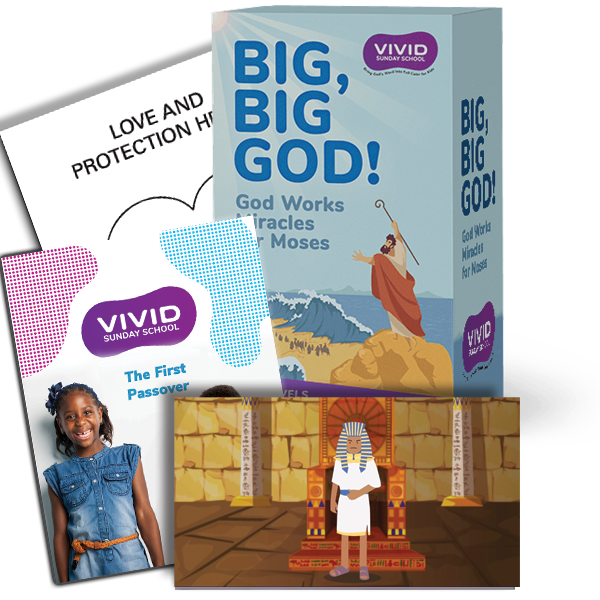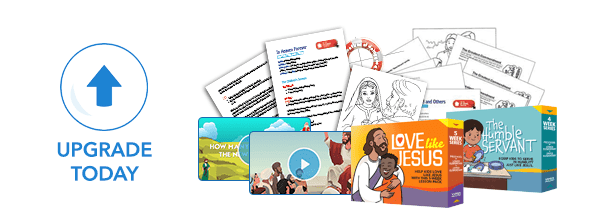Curriculum
The First Passover
Memory Verse:
“The blood shall be a sign for you on the houses where you live.” Exodus 12:13
Bible Background
What Kids Will Learn
God’s love and protection go hand-in-hand for His people, those who accept Him and His plan.
Scripture Summary
Moses and Aaron were in Egypt telling Pharaoh repeatedly to let God’s people, the Israelites, go. Repeatedly Pharaoh said no, and God sent plagues to the people of Egypt to display God’s power and to get Pharaoh’s attention.
The people of Egypt suffered greatly during the ten plagues: water turning to blood, frogs, lice, flies, livestock pestilence, boils, hail, locusts, darkness, and the killing of firstborn children. Yet, Pharaoh continued to refuse God’s demand for His people.
After 430 years of slavery, Passover was a holiday designed by God to celebrate the Israelites’ deliverance from Egypt. God knew this tenth and final plague, the plague of death, would be the final plague that would change Pharaoh’s mind.
God wanted to spare His own people from this devastating plague. God gave the Israelites specific steps to take for the Passover: selecting a perfect and innocent lamb, killing and eating the lamb, and spreading lamb’s blood over the doorposts. Eating the lamb while dressed for travel showed a trust in God and His plan of deliverance.
The lamb was a foreshadowing of the Lamb of God, the Messiah, shedding His innocent blood for our sins in the New Testament. As God moved through Egypt, He would then “pass over” each home with blood on the doorpost. In all other homes, all firstborn sons were killed.
Why Is This Important
God is powerful and will be sure His plans are carried out. While His plan is destructive to His enemies, His plan is protective to those He loves.
Teacher Devotion
Scripture
What Are You Wearing?
“This is how you are to eat it: with your cloak tucked into your belt, your sandals on your feet and your staff in your hand. Eat it in haste: it is the Lord’s Passover.” (Exodus 12:11)
God’s love and protection are powerful and comforting. We’ve all experienced His protection: spared from a company layoff, escaped near accidents on the road, or saved from loose footing on a mountain ledge while hiking.
The Passover instructions God gave the Hebrew people were incredibly specific for selecting and preparing the lamb, eating and disposing of the carcass, and planning the overall timeline for Passover. He also included directives for what the Hebrews were to wear while eating the Passover meal. The clothes God described were for travel.
God doesn’t want us to just endure His protection while the storms rage outside. He wants us to believe in His protection and anticipate what’s next. God’s protection itself isn’t the goal. God protects for a bigger reason–for something else coming. The Hebrews displayed a deep level of trust in God as they ate the Passover meal wearing traveling clothes. They were anticipating His deliverance from Egypt after all of this time.
What are you wearing as you experience God’s love and protection this week? You might be wearing traveling clothes anticipating a move. Or you might wear business attire for your next interview, casual clothes as you play with your children, or a favorite school sweatshirt as you head back to school. Trust in God to love and protect you and to prepare you for what’s next.
Prayer
Dear God, thank You for loving me and protecting me. Please help me follow Your instructions to keep me safe and look ahead for what You have in store for me. In Jesus’ name, amen.
Bible Memory Verse
You’ll Need: Several rolls of red crepe paper, Markers
Get Ready:
Before children arrive, unroll the crepe paper and write the verse on several rolls. Then roll the paper back up.
HELP CHILDREN FOLLOW THESE STEPS.
- Sit in a small group, spread apart from one another.
- A teacher will unroll the roll one word at a time and have the children repeat after them.
- Next the teacher will unroll the roll several words at a time and have the children repeat after them.
- Lastly the teacher will unroll the whole verse and see if the children can repeat it after them.
SAY: Today we will hear a true story of God’s love and protection through the first Passover.
Interactive Bible Experience
You’ll Need: Twizzlers candy for prizes, Bible
Get Ready:
Decide on an impossible task for your kids to do. (Examples: line up by birthdays in 30 seconds, guess everyone’s middle name correctly, or hit a target on the bullseye every time with a paper airplane.)
SAY: Are you guys up for a tough challenge today? If you complete the challenge, I have some fun red candy for you. If you fail, you will get no reward. Are you ready?
FOLLOW THESE STEPS:
- Explain and invite kids to try to complete the impossible task you decided on before class.
- When the kids fail at the task, remind them of their consequence.
- Then hand them each a red Twizzler for a reward.
ASK: Do you deserve this reward? Why or why not?
SAY: Just like you didn’t deserve this reward, we don’t deserve Jesus. We are imperfect. Jesus is a gift we don’t deserve. Just like blood saved God’s people during the first passover, His blood can rescue us, too.
Read aloud Romans 5:9.
Snack
Paint the Door Snacks
You’ll Need: Crackers, Red food coloring, Whipped white icing, Plastic knives— one per child, Paper plates, Hand wipes
Mix red food coloring into the white icing to make the icing as red as possible.
SAY: In the Bible, God told His people to paint their door frames with some of the blood of their lamb. If the blood was on the door, He would pass over and no one in the house would die.
Have kids follow these steps to make their Paint the Door Snacks.
- Pretend that the cracker is unleavened bread.
- Paint the red icing on their cracker like painting the door.
- Enjoy.
Game
Drape the Cross Game
You’ll Need: Red crepe paper—a roll for each team, A wooden cross (or a large cross made out of newsprint)
PLAY THE GAME AS FOLLOWS:
- Tear a 3-foot strand of the red crepe paper for each child to drape on the cross.
- Have children form a line and set the cross across the room.
- Give the first child in line a strand of crepe paper and invite him or her to run to the cross and drape the crepe paper around it, then run back to the line.
- When the child returns, have everyone cheer.
- Repeat this until each child has had a turn, then cheer again for everyone.
SAY: Great job! Jesus loves us so much He made a way for us to live in heaven with Him when He died on the cross. Even when we have ups and downs, Jesus loves us!
Craft
Red Cross Craft
You’ll Need: “The First Passover How-to Video”, Red crepe paper or red construction paper, Black construction paper, White construction paper, Glue
Get Ready: Before class, cut out a large cross shape in the middle of each black piece of construction paper. Make one per child.
SAY: Today we learned about God’s great care for His people. He loves and protects us, even when we mess up. Let’s make a cross to remind us of today’s Bible lesson. Give each child some red crepe paper or red construction paper. Help kids follow these steps to make their Red Cross.
- Rip up their red paper into little pieces.
- Glue their red pieces all over the white piece of construction paper.
Glue the black piece of construction paper on top of the white piece to reveal the red cross.
Prayer
Door Prayers
You’ll Need: Red construction paper, Markers, Tape
Get Ready:
Cut the red construction paper into squares.
SAY: In today’s lesson we learned that God told His people to put blood on their doors so that when He passed through they would be safe. We are going to make doorway prayers today.
Lead children in these steps:
- Give each child a red paper square and a marker.
- Ask children to tell you something they want to pray about, and write it on their square.
- Let children decorate the square.
- When they are finished, help children tape their request to the door of your room.
- Together, stand in the doorway and pray aloud over each request.
- Leave the red squares up for the next week and review them the following week.
Teacher Reviews
Review this content
Share your thoughts with others
Teachers say
No reviews have been added yet, be the first to review!

